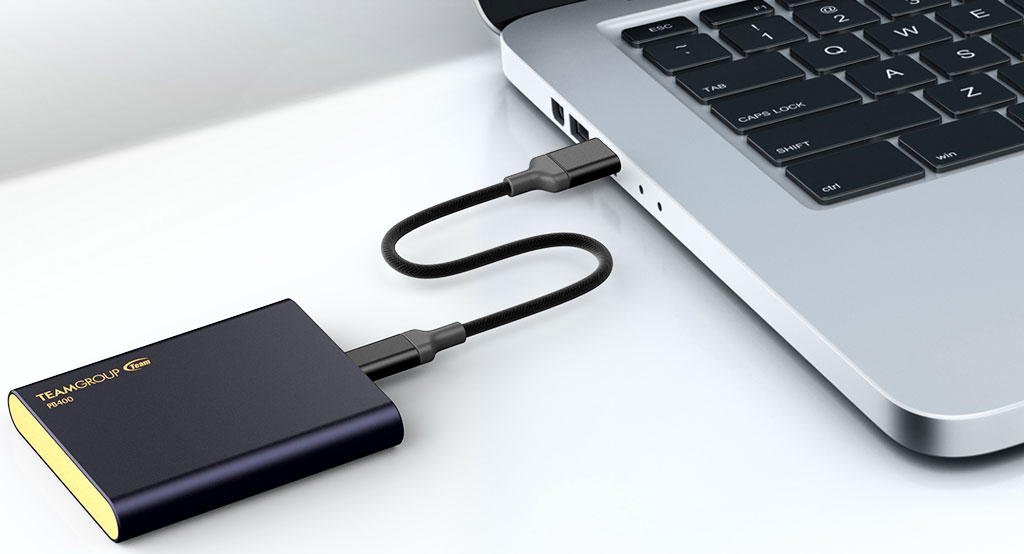Team Group launches a fast SSD for your PC and a slower one for your pocket
Storage for at home and on the go.

Team Group is expanding its solid state drive family with a couple of new products, the Cardea II and PD400. The former is an M.2 NVMe SSD that goes inside your PC (provided you have a relatively modern motherboard an available M.2 slot), while the latter is a portable drive.
Starting with the Cardea II (as shown above), this is a higher performing model that, at its fastest, is rated to deliver up to 3,400MB/s of sequential read performance and up to 3,000MB/s of sequential write performance.
On paper, that puts the Cardea II up there with some of the best NVMe SSDs available, at least for current motherboards. AMD and its hardware partners are getting ready to introduce new X570 motherboards with PCIe 4.0 support. The updated bus spec doubles the bandwidth of PCIe 3.0, and several drive makers have already announced PCIe 4.0 SSDs that up the ante with rated sequential read speeds of around 5,000MB/s.
As for the Cardea II, performance varies by capacity. Here are the sizes and speeds that are being made available initially:
- Cardea II 1TB: 3,400MB/s read, 3,000MB/s write
- Cardea II 512GB: 3,400MB/s read, 2,000MB/s write
- Cardea II 256GB: 3,000MB/s read, 1,000MB/s write
Even the 256GB model is much faster than any SATA-based SSD. The speed gains are negligible for gaming, of course, but can be useful for other tasks, like shuffling around large video files.
These drives come with a chunky heasink that Team Group says is specifically designed for gaming and high performance tasks, in terms of wicking away heat and resisting throttling. The heatsink uses a "patented gaming fin design." According to Team Group, it can be cooled down about 30C in an open space, and 10C in a close space, based on the company's own internal testing.
"When the transfer speed is higher than 1,000MB/s, the controller of the M.2 PCIe SSD will endure 70 of temperature while the center of the heat of the SSD is located at the controller. The T-Force M.2 PCIe SSD – Cardea II uses superconductivity—thermally conductive adhesive, which has a higher cooling coefficient than ice. The heat at the controller can be averagely transferred to the cooling module through superconductivity—thermally conductive adhesive to speed up the radiating process," Team Group says.
Keep up to date with the most important stories and the best deals, as picked by the PC Gamer team.
Team Group has more to say on the matter, but the general takeaway is that it is claiming these new drives deal with heat really well, to maintain high performance. We haven't tested these drives, so we can't say if it's actually one of the best SSDs for gaming, or any other task.

The PD400 is also an SSD, but of a much different type—it's an external drive that goes into your pocket, not your PC. Speed takes a back seat to portability on this one. It connects to PCs via USB 3.1 Gen 1 (Type-C on the drive side).
The Gen 2 spec doubles the bandwidth from 5Gbps to 10Gbps, enabling faster drives and transfer speeds. Nevertheless, Team Group opted for the slower spec. Speeds are still fast compared to a typical USB flash drive—the PD400 is rated to hit 430MB/s and 420MB/s for sequential reads and writes, respectively— but not quite on the level of Samsung's T5, the best portable storage drive in SSD form. Samsung's portable SSD is to reach up to 540MB/s transfer speeds.
The PD400 will come in 960GB, 480GB, and 240GB capacities.
Team Group did not announce pricing or availability for either of its new SSDs.
Paul has been playing PC games and raking his knuckles on computer hardware since the Commodore 64. He does not have any tattoos, but thinks it would be cool to get one that reads LOAD"*",8,1. In his off time, he rides motorcycles and wrestles alligators (only one of those is true).


